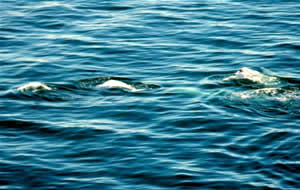
A pod of beluga whales. Photo: Captain Budd Christman, NOAA
NOAA Fisheries Service biologists estimate a beluga whale population of 375 in the Cook Inlet near Anchorage, Alaska, according to data collected during their annual survey in June. This population estimate is the largest since 2001.
"While we are encouraged by this higher estimate, further surveys will be required to determine if this is a reliable upward population trend," said Alaska Fisheries Science Center Director Doug DeMaster.
This year, NOAA Fisheries Service biologists flew five surveys over upper Cook Inlet waters June 9-15, and recorded video of beluga whale groups. The biologists calculate population estimates by examining the video taken during aerial passes over beluga groups and from counts made by researchers.
NOAA Fisheries Service declared the Cook Inlet beluga population depleted in 2000 under the Marine Mammal Protection Act. Since then, subsistence hunting has been conducted under co-management agreements between Alaska Native organizations and NOAA Fisheries Service, with restrictions on how many whales could be taken in a given year. The population, however, has not recovered as hoped. This year, the NOAA Fisheries Service proposed that the Cook Inlet beluga population be listed as endangered under the Endangered Species Act - a final determination is due in 2008.
Federal laws and voluntary efforts by the Alaska Native hunters have resulted in a limited hunt of the Cook Inlet beluga whales. Between 1999 and 2007 hunters took five beluga whales for subsistence in Cook Inlet â€" down from 308 between 1995 and 1998.
Cook Inlet belugas are one of five beluga populations recognized within U.S. waters - the others: Bristol Bay, eastern Bering Sea, eastern Chukchi Sea, and Beaufort Sea.
NOAA Fisheries Service researchers fly annual surveys in early June in order to take advantage of good weather during fish migrations when belugas concentrate near river mouths, especially by the Susitna and Little Susitna rivers, Knik Arm and Chickaloon Bay.
The Cook Inlet beluga population estimates since 1994 are: 1994: 653, 1995: 491, 1996: 594, 1997: 440, 1998: 347, 1999: 367, 2000: 435, 2001: 386, 2002: 313, 2003: 357, 2004: 366, 2005: 278, 2006: 302, 2007: 375.
NOAA Fisheries Service is dedicated to protecting and preserving our nation's living marine resources through scientific research, management, enforcement, and the conservation of marine mammals and other protected marine species and their habitat.
NOAA is dedicated to enhancing economic security and national safety through the prediction and research of weather and climate-related events and information service delivery for transportation, and by providing environmental stewardship of our nation's coastal and marine resources. Through the emerging Global Earth Observation System of Systems (GEOSS), NOAA is working with its federal partners, more than 70 countries and the European Commission to develop a global monitoring network that is as integrated as the planet it observes, predicts and protects.
